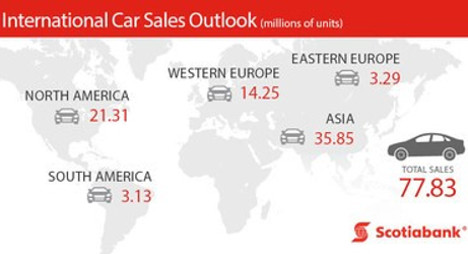The retail auto industry in Canada has experienced significant turmoil since early 2020 when COVID hit, both in the new and used markets.
Pile on economic shutdowns, production challenges, short new and used inventory, price hikes, and more, and you have a dramatically changing market.
In some ways the auto retail landscape is unrecognizable from pre-COVID conditions, although the march to normalcy is certainly underway, according to leading auto analysts.
Pushed by microchip shortage-driven new-car supply challenges, 36% of vehicle intenders this past year considered buying a used car instead of new, according to AutoTrader data. That’s up 10% year-over-year.
And pre-owned prices are finally trending downward, which will likely lead to more consumers entering the used market in 2023.
Daniel Ross, senior automotive analyst at Canadian Black Book, touched on future trends for the retail used-car market in a phone interview with Auto Remarketing Canada.
In recent months, the used auto industry has seen an increase in inventory and prices start to decline, according to Ross — trends that bode well for the market.
Prices normally see a bit of a spike this time of year, but the spring selling season is likely going to be a lot weaker than usual as prices work to normalize.
Kevin Roberts, director of industry insights and analytics at CarGurus, said, “From the data we have gotten, it looks like Canadian used sales have been performing better than new sales; this will continue into 2023.”
Again, this is all part of an overall normalization in the used market, according to multiple analysts and market observers.
Robert Karwel, senior manager of automotive at J.D. Power Canada, said, “Many in the industry are reporting that used rates are normalizing after record highs.
“The other big thing that we see allowing more used sales going forward is loan-term changes,” he said.
Karwel shared that last year, the number of 84-month loans accounted for 35% of all loans, accelerating heavily year-over-year. Karwel expects this 84-month trend to continue and perhaps accelerate, in turn making purchases more accessible for budget-conscious auto shoppers.
In fact, longer-loan terms were also one of the factors behind how Canada was able to propel any kind of successful used market last year, as well, while prices were astronomically high.
“So that’s (loosening of credit/loan terms) why I think you’re seeing a little bit of an overperformance of the used market compared to the new market right now in Canada,” CarGurus’ Roberts said.
The new market still has a long way to go in terms of recovery from production issues and impacts from COVID 19. New-vehicle prices are high in the current market, and inventory is still low.
For the new market to make a comeback and stand competitive with used vehicles, Roberts said that not only will inventory have to improve further, but also a wider array of vehicles need to be produced — and more cost-effective vehicles, at that.
“I really just see that as a market right now, especially with the high levels of inflation and economic uncertainty going into 2023,” said Roberts. “I think you’re seeing a lot more cost-conscious buyers out there, which is definitely giving some upside for used vehicles.”
Roberts encourages those in auto sales to focus on providing the widest range and kind of vehicles that they possibly can.
Ross at CBB said, “Dealers will need to focus on ‘buying well,’” further noting that a wide variety is key, but so is purchasing right and tracking days’ supply.
He also explained he sees keeping the sales process simple in general these days is crucial.
“It’s not an easy thing to do … There’s a lot of parties involved in purchasing vehicles, but if the forms are very digestible, the documentation much more than simply a large piece of paper with a lot of information on it, that’s going to bode well for dealers,” Ross said.
Perhaps like many dealers and consumers, the analysts who compiled the latest ADESA Canada Used Vehicle Price Index — powered by ALG — appear eager for spring to arrive, especially with the volume of new-vehicle sales in February.
The February index increased after being adjusted for seasonality with wholesale prices ticking up on average by 0.2 percent month-over-month.
Analysts indicated midsize SUVs showed the most drastic price decrease, sliding by 3.8 percent or $650. Next was midsize vehicles with a decline at 1.2 percent or $137. Minivans dipped 0.1 percent or $15.
Conversely, compact SUVs showed the highest price increase at 5.9 percent or $854, followed by full-size pickups at 5.7 percent or $1,545 and mid-compact vehicles at 2.6 percent or $246.
“With spring around the corner, Canada is moving towards the end of its comparatively slow winter sales season, bringing with it a 3.7-percent decline for February 2019,” ALG said in the latest update shared with Auto Remarketing Canada.
“With a total of 120,891 units sold, last month fell just under 5,000 units behind last February, and this decrease carried less of a sting compared to the previous three months. Overall, February 2019 settled in as the third highest-selling February on record, just ahead of February 2016 and behind February 2017,” analysts continued.
ALG reported that passenger cars have continued their descent, dropping 16.0 percent for the month. Meanwhile, analysts noticed the light truck market showed signs of life with a 1.2-percent sales increase. With this shift, ALG determined the light truck market accounted for 75.1 percent of total sales for the month.
Analysts acknowledged a number of double-digit decreases from selected brands in February kept the overall market suppressed. However, analysts added that February was not without its noteworthy trends, including:
• Hyundai and Kia outperformed the market and generated sales increases at 14.6 percent and 10.5 percent, respectively, with Genesis claiming a 283.3-percent sales increase.
• Lexus delivered a strong performance in February, claiming a 26.4 percent sales increase for the month aided by the introduction of its new Lexus UX.
• The big three German luxury brands — Mercedes-Benz, BMW and Audi — all recorded double-digit decreases for the month, declining 21.9 percent, 15.5 percent and 27.6 percent respectively.
• Volvo and Porsche also displayed strong single-digit sales increases for the month at 8.9 percent and 6.6 percent, respectively as both brands have entered 2019 strong.
“Spring traditionally brings with it higher sales for the Canadian market with volumes typically peaking around May or June,” analysts said. “As of now however, first-quarter results for the new light vehicle sales market are expected to fall short anywhere from 3 percent to 5 percent compared against 2018.
Thursday is the best day for auto dealership traffic in Canada. Consumers are keeping their cars an average of 11.5 years. According to research from global data company Freckle IoT, those are just two of many pieces of information that auto dealers should know, as targeting the correct core audience becomes more important.
Freckle IoT notes that technology and specific shopping behaviors are becoming more prominent factors in auto buying, and that means auto dealers should be armed with as much consumer data as possible.
In its report, “Freckle IoT Path to Purchase, Canada Automotive Footfall Report” for the fourth quarter of 2018, the data company noted various statistics that should interest auto dealers, such as the fact that 59 percent of car buyers spend time doing online research. Forty-six percent of shoppers use multiple devices for research, and six out of 10 shoppers are undecided on a specific vehicle when they enter a dealership.
The data company also released a report for the United States. (And one way the U.S. report differed from the Canadian report is that Friday is the best day for U.S. auto dealership traffic).
Like buyers in the United States, price and reliability are the No. 1 priority for Canadian buyers, according to the report.
Also similar to the U.S. report, the data on auto consumers is plentiful. The report notes that in Canada, the average consumer visits more than five dealerships before buying.
“It is essential to remember this and always be cognizant that you are not the only game in town,” the report notes, adding that consumers also spend an average of six months researching a vehicle they will potentially buy.
The survey also weighed in on the competition between traditional and hybrid vehicles, showing that consumers still prefer traditional.
“So, while the market pressures are playing to the trends with hybrid technology, the consumer still is not on the bandwagon fully,” the report states.
Freckle IoT accumulated the data for the survey by sending more than 8,000 surveys to its customers using its Killi app to uncover specific automotive shopping habits. The company also physically monitored more than 3,000 auto dealerships.
That data includes the top five activities that car shoppers conduct online. They are:
— researching car prices;
— finding actual cars listed for sale;
— comparing different models;
— finding out what their current car is worth;
— locating a dealer or getting dealer information
The report also addresses how dealers should market their vehicles to the public, and it mentions that the car sharing community is rapidly developing. By 2030, the report states, using PwC as a source, the share of autonomous driving could rise to as much as 40 percent.
“This will be a massive factor when developing a marketing plan,” the report states.
With half of 2018 already in the books, here’s a rundown of how certified pre-owned vehicle sales fared in the opening six months of the year, based on reports from individual brands and automakers.
Starting with Toyota, its 3,445 certified sales in June were up from 3,007 last June. Six-month totals are at 18,079 units, compared to 15,526 in the first half of 2017.
(Editor's Note: The synopsis of this story in the Auto Remarketing Canada Extra enewsleter incorrectly noted the six-month 2018 total as 3,445 units. Toyota moved 3,445 CPO units in June, and 18,079 in first half of 2018)
There were 539 Lexus certified vehicles sold in June, up from 439 a year ago. First-half sales totaled 2,537 units, compared to 2,167 in the first six months of 2017.
Nissan reported 720 CPO sales for June, up from 661 in June 2017. It moved 4,234 CPO units in the first half of 2018, down from 5,408 last year.
Infiniti’s certified sales in June were at 93, down from 101 a year ago. Through six months, it has retailed 553 CPO units, against 764 in the year-ago period.
At Porsche, there were 284 certified sales last month, up from 175 in June 2017 and “surpassing the previous best June result and establishing a new high-water mark sales month in the process,” the company said in a sales release.
First-half sales for Porsche climbed from 973 to 1,230.
Volkswagen stayed on a record trek with 1,929 certified sales for the month, up from 1,418 in June 2017.
VW moved 10,212 CPO vehicles in the first half of the year, compared to 7,798 a year ago.
Mercedes-Benz posted 1,262 CPO sales in June, compared to 1,316 a year ago. First-half certified sales were at 6,917, versus 6,969 in the opening half of 2017.
Volvo had 975 certified sales for June.
From a “torrid” auto sales pace to delinquency improvement in the Oil Patch, to perhaps Canada being in better position than its neighbor to handle the clash over trade with the United States, Matt Fabian shared plenty of positive developments stemming from TransUnion Canada’s latest Industry Insights Report.
Fabian, director of research and analysis for TransUnion Canada, began a conversation with Auto Remarketing Canada by highlighting that first-quarter auto loan volumes increased by 3.7 percent year-over-year, driven by an 8.5 percent increase in new auto loan originations.
Meanwhile, delinquency rates in the auto sector — contracts at least 60 days past due — fell by 12 basis points in Q1 to 1.7 percent.
“From our perspective, as the U.S. auto market has softened over the last several quarters we’ve been waiting for that to happen in Canada but it hasn’t,” Fabian said. “The first quarter of 2018 again we saw a record January and February, so there is still a torrid pace in terms of vehicle sales, which has fueled a lot of growth in auto loan volumes. We’ve seen a very active auto space.
"The risk protocols from the different auto lenders and the governance they’ve had have been pretty effective. Despite in the backdrop of a growing economy, growing auto sales and increased consumer debt, we still see fairly good risk behavior,” he continued.
TransUnion reported the average balance carried on their auto loans in Q1 stood at $20,786, a 3.5-percent rise year-over-year.
Oil patch improvement
Spurred by improved economic conditions and the continued recovery in oil prices, TransUnion found that oil producing regions such as Alberta and Saskatchewan are beginning to experience improvement in their respective consumer credit markets.
Fabian explained that improving credit performance in these provinces is arriving nearly four years after the start of rapid oil price declines at the end of 2014. Lower oil prices negatively impacted the local economies heavily tied to the energy industry.
In the summer of 2015, TransUnion published a report that projected credit product delinquencies in these regions to deteriorate at a faster rate than the rest of the country as a result.
Delinquencies did, in fact, rise in both Alberta and Saskatchewan. However, Fabian pointed out that Q1 may have been a turning point since TransUnion spotted the first significant annual decline since 2015.
TransUnion found that serious consumer delinquency rates (90 or more days past due) dropped by 15 basis points in Alberta and 39 basis points in Saskatchewan.
Signs of Recovery: Delinquency Rates Declining in Oil Provinces
| Consumer 90+ Day Delinquency Rates |
Canada |
Alberta |
Saskatchewan |
| Q1 2018 |
5.43% |
6.50% |
6.54% |
| Q1 2017 |
5.71% |
6.65% |
6.93% |
| Q1 2016 |
5.70% |
6.39% |
6.53% |
| Q1 2015 |
5.79% |
6.15% |
6.26% |
Source: TransUnion Canada
“We may be seeing the beginning of the consumer rebound in the oil producing regions out west. Economic conditions have been improving for a few quarters, as employment improves across the country,” Fabian said. “This is particularly good news for consumers in Alberta and Saskatchewan, as they were most negatively impacted by the oil crash from a few years ago.”
TransUnion recapped that oil prices reached $100 (USD) in Q1 2014, according to the U.S. Energy Information Administration, before declining to $48 in Q1 2015 and even further to $35 in Q1 2016. However, oil prices are back on an upswing and reached $63 as of Q1 of this year.
At the same time, Fabian mentioned unemployment levels in both Alberta and Saskatchewan have improved over the last few years. Alberta’s unemployment rate continued a strong downward trend to 6.3 percent in Q1 from 7.9 percent in Q1 of last year while Saskatchewan dipped slightly during that same timeframe — from 6.0 percent to 5.8 percent, according to data from Statistics Canada.
TransUnion also found that consumers in these regions also are limiting their debt exposure.
Analysts found that average non-mortgage debt balance per consumer in Alberta and Saskatchewan grew below the national average in Q1 from the previous year, at 1.9 percent and 2.5 percent respectively. The national average rose 4.5 percent in that same timeframe to $29,181.
“In times of crisis, we often see debt balances on products such as credit cards rise at greater rates, as consumers use credit increasingly to make ends meet. It is therefore a positive sign to see to see the use of credit in the oil provinces actually grow more slowly than the country overall rate,” Fabian said.
“When we compare the oil-producing provinces versus the non-oil-producing provinces, there is still a bit of a gap, but the encouraging thing is the trend,” he continued.
“It’s something we’ve been waiting for as the economy has rebounded,” Fabian went on to say. “It’s going to be a long tail for risk. You usually don’t see a recovery in delinquency happen until several months after. As the economy is coming around, we’re starting to see good signs.”
General credit trends
TransUnion also indicated the first quarter of 2018 was highlighted by continued solid performance by Canadians in most parts of the country.
The number of consumers with access to credit increased by 1.2 percent on an annual basis to close Q1 2018 at 28.6 million. The 90-plus days past due average consumer delinquency rate also dropped on an annual basis by 28 basis points to 5.4 percent in the same timeframe.
Accounts entering collections status also declined by 21 percent to 0.7 million between Q1 2018 and Q1 2017.
The overall risk tier mix of Canadian consumers in TransUnion’s national consumer credit database improved in Q1 2018, with 68 percent of consumers considered prime or better — a 2.2-percent increase over last year. The super prime (lowest risk) segment grew the most with an increase of 76 basis points, while the proportion of subprime (highest risk) consumers in Canada declined by 36 basis points from last year.
“We continue to see strong consumer credit performance over the past year, with apparently limited impact due to the rising interest rate environment. This dynamic is something we will continue to monitor,” Fabian said.
Talking trade
Much has been publicized about the trade discussions involving Prime Minister Justin Trudeau and President Donald Trump, who are both laying out the positions of Canada and the U.S., respectively.
Without delving into the politics of these trade exchanges thus far, Auto Remarketing Canada asked Fabian about the potential implications on dealerships and auto finance companies, depending the severity of tariffs implemented.
“From the auto sector, it could affect productivity and output, depending on what tariffs are put on and how the negotiations go,” Fabian said. From a manufacturing and output perspective, it’s going to effect to impact manufacturers, which could in turn lead to things like layoffs or reduced production. There could be pockets of Canada in the auto producing regions, like Ontario, affected from a broader macroeconomic scale and unemployment.
“It also could lead to higher auto prices based on the tariffs that could affect demand from a dealer and sales perspective. That might be the thing that triggers the slowdown in vehicle sales,” he continued.
“But honestly the biggest hit is going to be on the U.S. There is going to be a serious shortage going into the United States as a result,” Fabian went on to say. “The United States doesn’t necessarily have more capacity to build more vehicles. The prices of vehicles in the U.S. could go up quite radically.
“It's going to affect both sides, but from a Canadian perspective you’re going to see those pockets that have a reliance on manufacturing,” he added. “We might see more stress in those areas. I don’t know if it will manifest itself any more than that, but there is that potential headwind.”
Last month was the best August ever for new-car sales in Canada and a 7-percent improvement over year-ago figures, according to Scotiabank.
Pickup truck sales were particularly strong during the month, and they’ve had an especially stout performance this year in Alberta, the company said in an Auto News Flash released Tuesday.
Scotiabank said there was a 20-percent year-over-year spike in pickup sales for the month, with the Prairie provinces climbing as well as business investments.
Alberta is where these vehicles are getting the most attention. Sales there for pickups have climbed 30 percent year-to-date, the company said, and they have a 35-percent market share in the province. That’s about twice as strong as the rest of the country.
Overall, the annualized rate of new-car sales in Canada in August was, once again, more than 2 million units, Scotiabank said in Tuesday’s report. This was driven by double-digit sales spikes for domestic and import light trucks.
A week ago, Scotiabank published its Global Auto Report, with sales forecasts/figures through July.
The company was predicting an estimated 2 million new cars to be sold this year, down from annualized rate in the first six months of the year (2.044 million) but up from the 1.949 million new-car sales in 2016 and 1.898 million sales a year earlier.
The certified pre-owned market in Canada appears like a healthy one for those reporting monthly and quarterly sales to Auto Remarketing Canada.
Starting with Audi, not only was March its best-ever month, the first quarter was Audi’s best-ever start to a year, the company said.
Audi’s CPO sales climbed 38.5 percent year-over-year, with 727 units moved in March. Through three months, Audi’s numbers are up 16.3 percent with 1,624 sales.
BMW, which includes both CPO and non-CPO in its numbers, said it sold 2,070 pre-owned units for the month (up 14 percent) and 5,011 (up 13 percent) in Q1.
“March represents the best pre-owned sales month on record for BMW Canada,” said Robert Staffieri, national manager, pre-owned sales at BMW Canada. “Strong CPO market messaging, along with the ability of our retailer network to deliver an exceptional buying experience continues to resonate with consumers.”
Next up, Toyota sold 2,594 certified vehicles in March, up from 1,921 a year ago. In the first quarter, it moved 6,618 CPO units, up from 4,696 in Q1 2016.
Volvo had 179 certified sales in March, up from 159 a year ago. It moved 490 CPO vehicles in Q1, up from 394.
Mercedes-Benz reported CPO sales climbing 5.2 percent year-over-year in March, reaching 1,379 units. It sold 3,030 CPO units in Q1 (up 8.0 percent).
As the company prepared to share its 2016 used- and new-vehicle sales totals, AutoCanada announced late on Thursday that Thomas Orysiuk is resigning from his position as president and as a member of the company’s board of directors.
The dealer group said Orysiuk’s resignation as president and director is effective on Friday, and AutoCanada chief executive officer Steven Landry would assume the role of president and CEO.
“On behalf of the board of directors, we sincerely thank Tom for his many years of dedicated service as an officer and director of AutoCanada — and particularly in this year of transition,” Landry said. “We wish him all the best in his future endeavors.”
The executive action coincided with AutoCanada releasing its fourth-quarter and full-year financial statement, which included reports of annual revenue and gross profit staying nearly flat year-over-year.
The company said revenue from existing and new dealerships came in at $2.89 billion in 2016, down slightly from the 2015 figure of $2.90 billion. Its gross profit from existing and new dealerships remained flat at $486.1 million in 2016, as a year earlier it was $487.7 million.
Looking at how the dealer group moved metal, AutoCanada reported that its 55 stores retailed a total 19,561 used vehicles in 2016, down slightly from the 2015 total of 20,342 used units. On the new-model side, AutoCanada said its combination of retail and fleet transactions resulted in a sum of 40,032 units last year; that’s down by 2,425 units year-over-year.
“Fiscal 2016 capped off the second consecutive year where our core markets faced deteriorating business conditions. However, wherever there are challenges there are also opportunities, and I believe AutoCanada is well-positioned to execute on its strategy and create value for shareholders,” Landry said.
“We are responding to economic conditions in our key markets by focusing on market share, operating expenses, accretive acquisitions, and delivering consistent performance across all of our dealerships,” he continued.
Contained within the company’s outlook for 2017, AutoCanada said it plans to spend approximately $30.9 million on dealership relocations and expansions.
“We are under construction on the relocation of Audi Winnipeg, which we anticipate will lead to increased customer traffic and sales. We also plan to begin construction on two new open-point locations in Calgary and Ottawa,” the company said.
AutoCanada went on to mention its five-year capital spending outlook is approximately $145.3 million.
“This level of spending, along with the company’s current dividend commitments, are expected to be balanced with internally generated cash flow,” AutoCanada said.
AutoCanada also announced that it has executed an agreement with its syndicated lending partners to amend and restate its $250 million revolving credit facility while extending the maturity date of the agreement by two years to May 2020.
Although there were no changes to the composition of lenders included in the syndicate, AutoCanada indicated HSBC and RBC will co-lead the agreement while HSBC will retain its position as sole book-runner and agent.
Under the terms of the new agreement, AutoCanada pointed out there are no changes to the $250 million borrowing limit or debt covenants although modifications have been made to the facility pricing grid, which the company anticipates will allow for more effective management of financing charges.
“Despite the sustained economic challenges of the past two years, this new agreement highlights the unwavering confidence our lending partners, HSBC, RBC and ATB, have in AutoCanada and their continued support for the growth and success of our company,” AutoCanada chief financial officer Chris Burrows said.
“We believe that this agreement will allow us to continue to pursue and implement our strategic vision and underlines the strength of our relationships with our valued financing partners,” Burrows added.
Dealer performance will be one of the many topics discussed, as there are more than 100 people from 74 different dealerships registered for the Auto Remarketing Canada Conference, which will be held April 3-4 at the Westin Harbour Castle in Toronto.
And the list has been growing steadily, say conference organizers.
If you’d like to connect with these folks, make sure you register for the conference today.
Canadian new-car sales began the year in rapid fashion, but take that with a grain of salt.
It is likely that 2017 will be the end to a four-year streak of record sales in Canada, according to Scotiabank.
The company’s latest Global Auto Report indicates that the annualized new-car sales pace in January was more than 2 million units; however, it’s projected that Canada will actually end up selling 1.94 million new cars this year.
That would be down, albeit slightly, from last year’s record 1.95 million new-car sales.
“Recent price increases for new cars and light trucks have started to dampen affordability, and will likely outweigh the positive impact of stronger economic growth in Canada this year,” Carlos Gomes, who is Scotiabank’s senior economist and auto industry specialist, said in a news release accompanying the report.
“Although vehicle sales in the commodity-producing provinces are finally starting to recover from the sharp double-digit declines of recent years, activity in the rest of the country is likely to trend lower,” he said.
Alberta is expected to lift new-car sales from 220,000 units to 223,000 units this year, and Saskatchewan is projected to see its new-car sales rise from 51,000 to 52,000.
This would mark the end of a downward slide in Alberta car sales that reached a 30-percent peak-to-trough downturn, Scotiabank said.
“Firmer oil prices and the rebuilding in Fort McMurray are expected to boost economic growth in the province to around 2 percent this year, reversing the first back-to-back annual economic contraction since the early 1980s,” Scotiabank said. “Economic activity and vehicle purchases are also bottoming in Saskatchewan with late-2016 sales largely in line with a year ago.”
And considering that there was close 20-percent peak-to-trough downturn in Saskatchewan through the third quarter, that’s solid progress, Scotiabank said. .
The two other Western provinces are likely to show stable new-car sales: Manitoba at 56,000 and British Columbia at 215,000.
“B.C. has been the second strongest auto market in Canada in the latest expansion and we expect sales to remain unchanged this year as economic activity remains solid outside of a less-hot Vancouver housing market,” Scotiabank noted.
Manufacturing boosts should buoy sales in Manitoba.
However, the Atlantic provinces are likely to see sales drop from 140,000 to 135,000 — this would be a four-year low, according to Scotiabank.
As for the central provinces, Quebec will likely see a dip from 465,000 new-car sales to 463,000, with Ontario’s new-car sales declining from 802,000 to 796,000.
Granted, Ontario’s projection is coming off a peak year and is largely due to “slightly lower” production expected for 2017. And though Quebec will likely be softer, this would be the second straight year of more than 460,000 sales. Higher export volume and the country’s highest leasing penetration are driving this strength, Scotiabank said.
Following several years of record new-vehicle sales in Canada, purchases are likely to lower in 2017, according to the latest Scotiabank Global Auto Report.
This year, Canada’s car volumes can be expected to be handicapped by recent price increases for new cars and light trucks, as well as lower replacement demand than in the U.S., said the report.
There were 1.9 million new-vehicle sales in Canada in 2015, with 2016 sales estimated to have reached 1.95 million units. The forecast for 2017 is a modest dip to 1.94 million.
This is still higher than the 1.27 million annual sales averaged between 1990 and 1999, the 1.61 million from 2000-13 and the 1.85 million new cars sold in 2014.
"In the United States, we see increased replacement demand, growing consumer confidence and attractive financing options, lifting sales for the third consecutive record year," said Scotiabank senior economist and auto industry specialist Carlos Gomes, in a news release.












